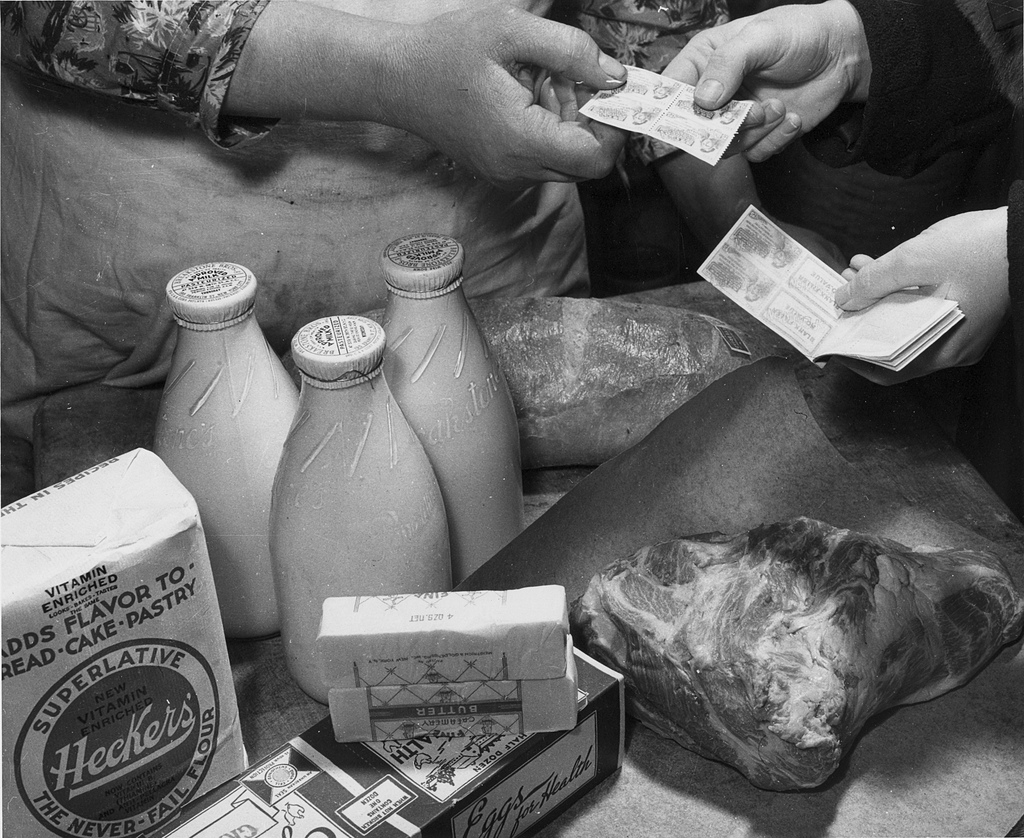
- The first food stamp program was created in 1939 to help Americans weather the Great Depression.Photo Credit: National Archives and Records Administration
AMY: It’s been a little more than seven decades since the food stamp program was enacted in an effort to help America through the Depression. The program ended in the early 1940s, only to be resurrected again in the ’60s and bolstered heavily in the 90s. Today, a record number of Americans — more than 47 million — rely on food stamps, otherwise known as the Supplemental Nutrition Assistance Program or SNAP.
Like many entitlement programs, SNAP has critics and supporters. I can’t tell you who’s right, but I can tell you this: I once received food stamps. I was putting myself through school and, and though working full time, was still struggling to make ends meet.
At the time, I felt humiliated because of the stigma attached to “welfare.” Years later, I’m now almost embarrassed to admit that I typically spend in two weeks what the average recipient receives for a whole month – about $133, according to the Kaiser Family Foundation.
When was the last time you tried to buy three meals a day on less than $4.50?
APRIL: As anyone who does so weekly can tell you, it’s not easy. One reason is that the best strategies for stretching a small food budget to the limit are also extremely time-consuming.
First, there’s comparing stores’ weekly mailers for deals. Before you shop, you’ll want to plan meals that get you the most for your buck. Clipping coupons takes time, particularly if you’re matching them up with weekly in-store promotions. Then there’s money spent traveling to different locations to get those super-sales. Once you’re in the store, if you’re being really savvy, you need to compare unit prices (per pound or ounce) to get the best value.
Then there’s cooking from scratch — one of the best ways to squeeze multiple meals out of a tight budget. Add in a full-time job (or more than one) and taking care of a family, and staying within that daily $4.50 per person budget can be even harder than it already sounds.
But, as Amy has noted, millions of Americans do this regularly. I’ve been fortunate enough to have never had to walk this balancing act, but I have loved ones who have, and do. It can take just one lost job, one health setback or another stroke of bad luck to find yourself in need of assistance.

- Clipping coupons can help save money, but it also takes time.Photo Credit: ‘StockMonkeys.com’
Again, we’re not experts — nor do we pretend to be — but there are resources to help with strategizing and supplementing food stamps.
AMY: Three places come to mind immediately for folks trying to supplement a tiny food budget: food banks, churches and charitable organizations. Finding these might take a little digging, but I found a few in our area (Washington, D.C.) by searching”free food DC” on Google. This resource, Food Harvest, looked promising, as did this food bank locator. Calling local churches and checking with social service organizations would be another good place to start.
I think the simplest and healthiest thing one could do, if you have space for it, is to grow your own. SNAP benefits can be used to purchase food-producing seeds and plants. Investing just a few dollars in a tomato plant can provide unbelievable bounty (check out some great resources at the nonprofit SNAP Gardens). Clean waterways nearby? Go fishing. Foraging is another option.
APRIL: Back to meal planning, where another good strategy is buying not just inexpensive foods, but ones that leave you satisfied. Luckily, there are a quite a few good staples that fit the bill, so to speak: brown rice, dried beans, eggs, oatmeal, yogurt, cabbage and other greens to name a few.
Cooking from scratch is more time-consuming than eating pre-packaged foods, of course. But cooking large amounts of staples at once, like beans and brown rice, can cut down on prep time through the week, as does storing portions of prepared foods in the freezer.
While many good staples are relatively inexpensive, eating a variety of fresh fruit on a food-stamp diet can be a challenge. Bananas are cheap, but add in apples, oranges and grapes, and your costs rise quickly. This is where monitoring store specials and buying in volume can help. Purchasing a 3-pound bag of apples can drop the bill from around 1.50 per pound to about 75 cents, for example.
SARAH: Ok, we’ve done our research. Combed through advertisements. Figured out ways to supplement. Run the numbers. But we still need to figure out what to do with these hearty, cheap staples.
Simplifying your meal plan by distilling down to basics that are hearty and filling will help greatly. This will also help save time in preparation and shopping; you’ll know which items to look for every week.
 You should also choose meals that are flexible and forgiving with their ingredients, meaning you can swap one veggie or starch for another, depending on what’s on sale. This also breaks the monotony of making the same meals again and again. There are a ton of great recipes that fit the bill on all of these counts:
You should also choose meals that are flexible and forgiving with their ingredients, meaning you can swap one veggie or starch for another, depending on what’s on sale. This also breaks the monotony of making the same meals again and again. There are a ton of great recipes that fit the bill on all of these counts:
- Most cultures have some take on hash — a mixture of meat, potatoes and spices. The dish’s inherent diversity makes it easy to swap out ingredients and flavors. Whether you make the Irish corned beef hash or the Latin American picadillo or even a meatless hash, your plate will be filling and flavorful.
- Casseroles lend themselves extremely well to simple meals made with cheaper, hearty staples. Typically, they call for a wide variety of ingredients within our price point, like starches such as rice, beans, lentils and pasta. Veggies, either fresh, frozen or canned, depending on what’s on sale. Proteins like canned tuna or bone-in chicken (legs and cut-up chickens are often super-sale items at the grocery).
- Quiches are another simple dish with many ingredient permutations. Made without crust, it becomes even easier. Mix nearly any green along with cheese or meat with eggs and milk and bake. So simple and works for breakfast, lunch or dinner.
- Fried rice, made with cooked rice (day-old is best) and nearly anything else chopped small and thrown in, is yet another great meal that meets our needs. Whether you throw in veggies, meat, eggs or even leftovers from a previous meal, it’s quite simple to compose a hearty one-dish meal.
AMY: Living on any kind of budget is difficult, but living on food stamps can be a particular challenge – and one many of us can’t fully appreciate. Our goal here was not to pretend we could, but to offer some options for those that can use them.
We’re open to your ideas, too. Whether you’re on SNAP or just stretching a small budget, what do you do to make ends meet and still end the day with food in your belly?




While I’ve never been on food stamps, buying groceries and cooking on a budget is dear to my heart. One of my favorite stores in Erie, PA that helped with this was Erie County Farms. Fruits & vegetables, meats, deli meat & cheese, and seafood… all fresh and at ridiculously low prices. I’d like to throw in one of my favorite budget-friendly meals: chili! With or without meat (maybe a pound of ground beef when you can find it for $1.99/lb), different types of beans, diced tomatoes (fresh or canned), maybe a veggie or two (onion, bell pepper) and some seasonings. Make a big crock pot worth and freeze some for later. Hearty, filling, tasty, pretty healthy, and affordable. Gumbo is along those same lines, too, and you just have to cook up some rice with it.
Hey, Amanda! Love the chili tip. It’s such a great way to pack in some extra veggies, too — and even if you plan to do an all-veg version. I like mine spicy. Really spicy!
I second the chili tip. I make a meatless version with lentils that has been a staple for my toddler since he’s been eating solid food. Freezes well, tons of nutrition (lentils, garbanzo, and black beans!) and super cheap.
Decades ago I read a book called”Miserly Moms” (for free thanks to the public library). It gave real practical steps on saving with groceries including the math to help you realize how much cooking from scratch does save. Soup once a week has really helped. Everyone expects it. It is often free as I use mostly leftovers, extras, and waste from other meals. Plus in proud of how I’ve learned to make creative nourishing soup. And I love serving free food.
I’ve never been big on soups, until recently. I am such a big fan of grains like barley, amaranth and millet. I think soups are a great way to get more of these into your system, and as you said, a perfect way to use leftovers to create a nourishing meal. Thanks for the tips!